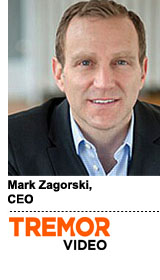
Tremor Video, one of the earliest video ad nets, has sold its demand-side business to the Israeli mobile ad platform Taptica for $50 million, the company revealed Monday.
Tremor’s buy-side assets will be housed under an independent business division within Taptica called Tremor Video DSP. All of Tremor’s buy-side employees, led by longtime Tremor exec Lauren Wiener, will join Taptica.
Tremor employed about 350 people prior to the divestiture, and said there’s a roughly 50-50 split between buy- and sell-side staff.
Mark Zagorski, the former Nielsen exec who became Tremor’s CEO in early June, said the divestiture was a calculated move to help Tremor focus on its sell-side business, which has grown about 80% to about $34 million in net revenue over the last 12 months.
Clients were also uneasy with Tremor servicing both the buy- and sell-sides.
“There’s always been a little bit of friction because we were selling agencies and advertisers different products while we were representing publishers,” Zagorski said. “And the people who plug into that sell-side platform would always be somewhat hesitant to commit to it in a huge way because we had that perceived conflict.”
It was essential for Tremor to lose that friction, especially as legacy TV publishers offer up more inventory programmatically.
Zagorski thinks Tremor is now in a good position to capitalize on exploding OTT demand.
“This allows us to tell a very straightforward and simple story to the market – that we’re focused on maximizing the monetization of video inventory for leading premium publishers on any platform through software,” Zagorski said, adding that video is very service-based with complex technical challenges.
“You can’t just do it as a side business to display, which is why Pubmatic, Rubicon and AppNexus have not really made a dent in this business at all on the video side,” he added.
Tremor Video’s SSP business just signed on broadcast publishers like Sinclair and Tribune Media, in addition to doubling down on connected TV deals with clients like Hulu and Sling TV.
And the SSP was a major growth engine during Tremor’s most recent quarter.
“It was logical for us, being at the scale we were, to focus on one part of the business with the highest growth and margin profile and where we have considerably less overhead,” Zagorski said.
Tremor’s demand-side divesture was arguably a defensive move, as well.
Its DSP didn’t capture the growing percentage of video ad spend going to large social platforms like Snap and Facebook.
And competitors like video DSP TubeMogul (now Adobe), which had secured those direct integrations to Snap and Facebook, were rewarded handsomely – $540 million, to be exact – for it.
Post-transaction, Tremor’s cash flow will exceed $80 million, which will help the ad tech company to continue to grow through acquisition if necessary.
Buying Tremor’s DSP will give Taptica, which grew its revenue 66% to $125.9 million last year, instant foothold in the US video market and access to Tremor’s brand advertiser base.
This post was syndicated from Ad Exchanger.

More Stories
WBD Introduces Out-of-Home Member Plan as It Begins Max Password Crackdown
Deep Blue Is Building a Women’s Sports Yacht Club at Cannes
Sinclair SVP of Station Operations to Retire in June